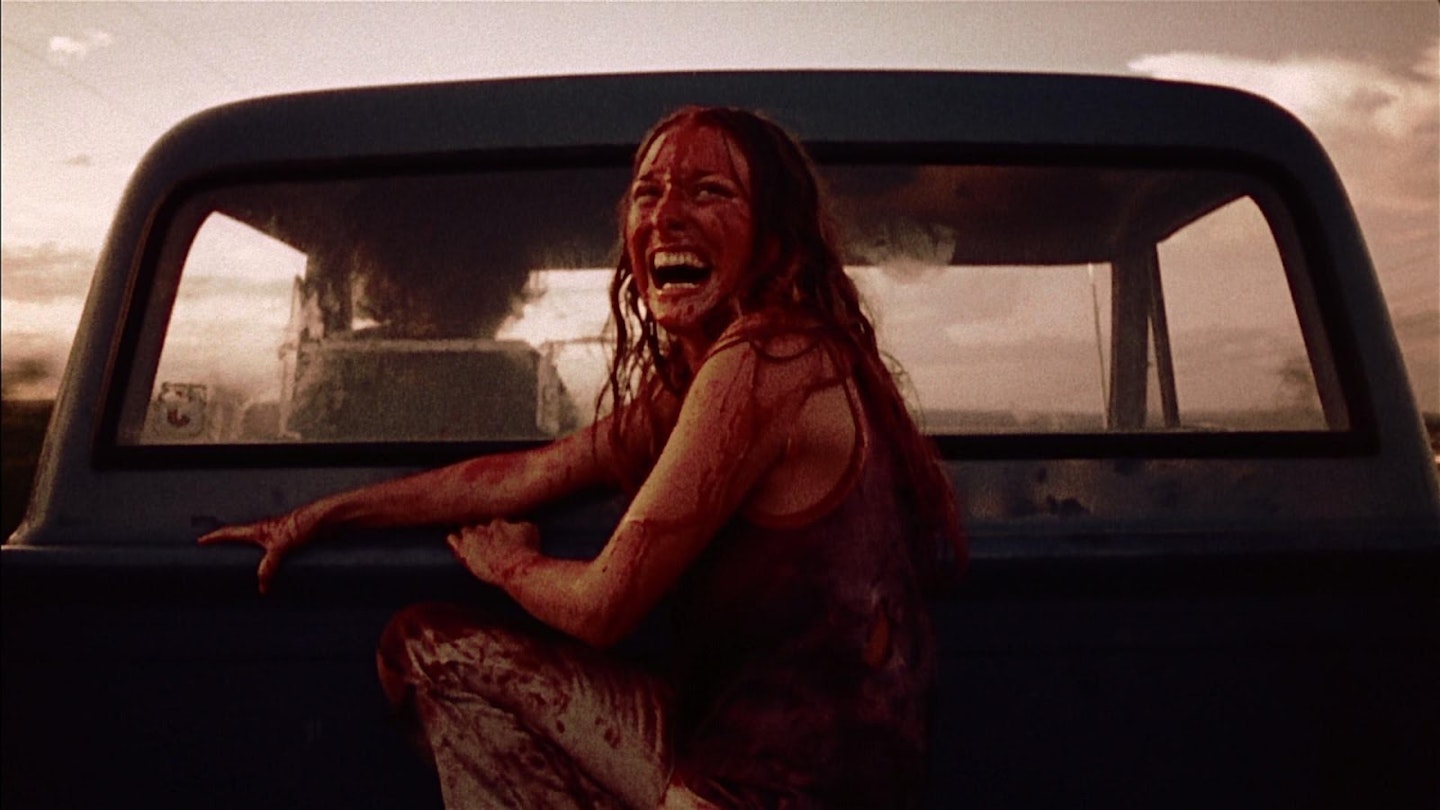The outright sensationalism of Tobe Hooper's regional horror masterpiece begins with its eye-grabbing, unforgettable title. It takes real guts to be so blatantly up-front. More guts, in fact than are spilled in the movie.
Nothing could possibly be as bloodily atrocious as title and poster ("Who will survive, and what will be left of them?") suggest that The Texas Chain Saw Massacre will be, so Hooper goes the other way. There are no close-ups of open wounds (a gore film trademark since H.G. Lewis' Blood Feast (1963) and all limb-lopping happens out of shot (though patrons who cover their eyes and just listen to buzzing and screaming might imagine things no non-snuff filmmaker could put on screen). Instead of the single mummy of Psycho (1960), which was also based on the real-life story of Wisconsin ghoul Ed Gein, Hooper has a whole houseful of human and animal remains artistically arranged to freak out the unwary visitor.
Rather than Alfred Hitchcock's delicate, suspenseful manipulation, Hooper follows the lead of fellow independents George A. Romero (Night Of The Living Dead (1968) and Wes Craven (Last House On The Left (1972) and feeds the audience through a mangle of unrelenting horror and violence. Once his film starts, it doesn't let up until the fade-out: other horror films are as frightening, but few are so utterly exhausting.
We begin deep, deep in the heart of Texas, where dead armadillos curl by the roadside and violated corpses are arranged like scarecrows. Unfriendly locals snarl in incomprehensible accents and the 70s economic downturn has scattered the landscape with abandoned farms and disused slaughterhouses. A group of vapid teenagers in a Scooby-Doo bus, with a whining cripple (Paul A. Partain) in place of the big dog, take a trip that ends when they unwisely enter an old, dark house. The apparent leading man, a real Freddy type, wanders down a filthy corridor towards a red room walled with animal trophies. Suddenly, without any Hitchcockian overhead shot to pre-empt the shattering shock, Leatherface — a squealing, obese goon in a tanned skin mask — appears from nowhere and smashes in the kid's head with a sledgehammer. Before you've had time really to register what you've just seen, the killer (Hansen) slams an unexpected, grating steel shutter across the corridor and, out of the audience's sight, finishes off the still-twitching boy.
Leatherface slaughters three more teens in quick succession, using a meathook, the sledge, and a buzzing chainsaw. The fleeing Sally (Burns), Daphne in white flares, is repeatedly caught in brambles and bushes that the killer easily saws his way through. The girl winds up at the mercy of the down-home cannibal clan, a combination of the Addams Family and the inbred rednecks from Deliverance (1972). Out of work since the abattoir shut down, they keep to the old ways by treating passing strangers the way they used to treat beef cattle. The nameless degenerates (they become the Sawyers in the sequel) are a parody of the sitcom family, with the bread-winning, long-suffering garage proprietor (Siedow) as Pop, the bewigged, apron-wearing Leatherface as Mom, and the rebellious, birthmarked, long-haired hitchhiker (Edwin Neal) as teenage son. The house is a similarly overdone, degraded mirror of the ideal home. Impaled clocks hang from the eaves, an armchair has human arms, and a hen is cooped up in a canary cage. Sally is served up at a family meal, presented to the centenarian half-dead Granpaw ("The best killer of them all") to be killed. She survives, but only because the human corpse can barely hold the hammer he uses to smack her skull. This may be the most unpleasant scene in any 70s film. The family cackle and taunt like mad children while Sally screams and rolls her eyes in extreme close-up, certain that she won't live through the night. With an unlikely burst of superhuman strength, Sally breaks free and crashes through a window. On the main road, the hitch-hiker is messily run over and Sally clambers into the back of a speeding pickup truck. She survives, but as a blood-covered, shrieking, probably insane wreck. We fade out on a long shot of the enraged Leatherface whirling his chainsaw in the air.
The film has outstanding sound effects, art direction and editing, and a clutch of effective, if necessarily, one-note performances. Unlike the notorious and comparable I Spit On Your Grave, (1978) Chain Saw is not a complete turn-off. If Hooper and his collaborators do not make their subject palatable, they succeed in justifying their film with sick panache. With a surprising amount of intentional comedy, the film is an important precursor to the horror comic style of Wes Craven's The Hills Have Eyes (1978), Sam Raimi's The Evil Dead (1982) and Stuart Gordon's Re-Animator (1985). Hooper reprised the tone of Chain Saw in the demented Death Trap (1976) (the one where the crocodile eats the puppy) and in The Texas Chainsaw Massacre 2 (1986), with Dennis Hopper and bolstered chainsaw. The franchise was resurrected for Leatherface: Texas Chainsaw 3 (1990), with Viggo Mortensen, and for Return Of The Texas Chainsaw Massacre (1994), with Renee Zellweger and Matthew McConnaughey. But TCSM is one of those "there'll never be another" movies.


